Part 3: Dances of Central and Northern Europe
9 Dances from Germanic Europe
1. The Germanic Countries
The Germanic countries all have majority speakers of the Germanic branch of the Indo-European language family, spread throughout Northern Europe. In classical times, these people were a mixture of small agrarian farmers and hunter-gatherers; but, in either case, they were famous to the Romans for their fierceness. In the 4th to 6th centuries CE, the Germanic peoples began their migratory period. The Huns sacked Rome. Spain was conquered by the Goths and the Visigoths. Gaul (France) was invaded by the Franks, and Britain was occupied by the Angles, the Saxons, and Jutes. This was the time that the Norse (i.e., Viking) cultures started to emerge in Scandinavia. The Modern Germanic languages include German, Dutch, English, Frisian, Danish, Swedish, Norwegian, Scots, Afrikaans, Yiddish, Faroese, and Luxembourgish
Leaving aside Britain, the modern Germanic countries can be classed into three groups:
- The Scandinavians in Iceland, Sweden, Norway, and Denmark. Scandinavia also includes some non-Germanic peoples and countries: Finland has speakers of Swedish, but the bulk of its population speaks Finnish, which is a Finno-Ugric language related to Hungarian; we also find indigenous communities in the far north like the reindeer herding tribal people called the Saami. We will include Finland in our discussion here because its music and dance is like that of the rest of Scandinavia, even though the Finns are not Germanic speakers.
- The Low Germans (The Dutch and the Flemish) who live in the Netherlands, Belgium, and Luxembourg.
- The Central/Eastern Germans who live in Germany, Austria, Lichtenstein, and Switzerland.
2. Scandinavia
Scandinavia consists of Iceland, Sweden, Norway, Denmark, and Finland. The classic stereotype of Scandinavia is that of the Vikings, and the Vikings indeed had an oversized influence on Europe. They conquered and attacked Britain, Ireland, and France. They conquered Paris, and it is thought that they made it as far as North Africa and the Levant (Israel). Archeological evidence also places the Vikings as far afield as Greenland and North America. After the Vikings, a series of important empires emerged from Scandinavia: The Kalmar Union, The Kingdom of Norway and the Kingdom of Sweden held sway, not only over Scandinavia, but also in other places, such as northern Britain. At one point, Sweden had the most powerful navy in the world.
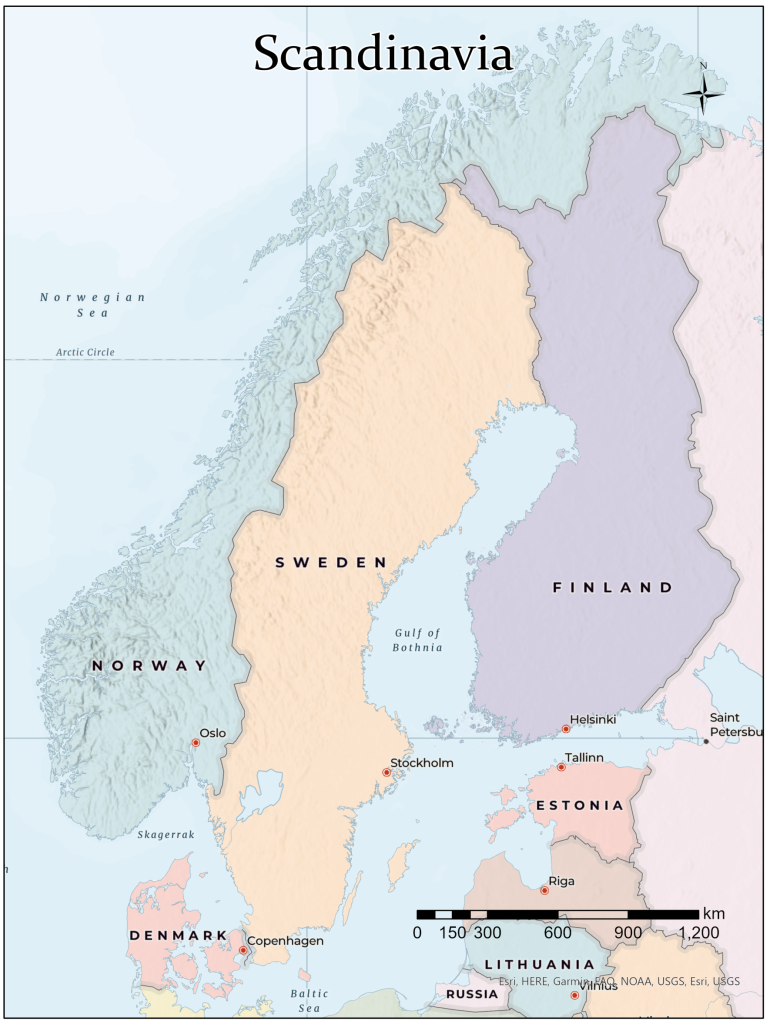
2.1. Costumes
Scandinavian costumes are often made with wool cloth and died in dark colors, usually black, blue, or red. Women’s skirts are often ankle-length and, in some regions, include an apron that is sewed onto the skirt. Peaked caps and hats are common and reflect the region’s traditions of gnomes and elves.
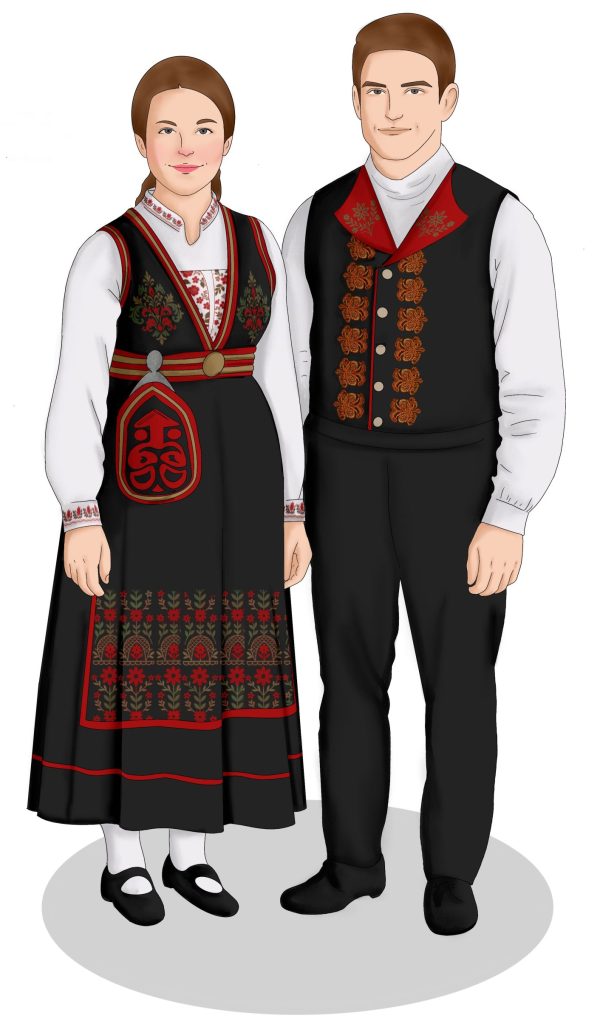
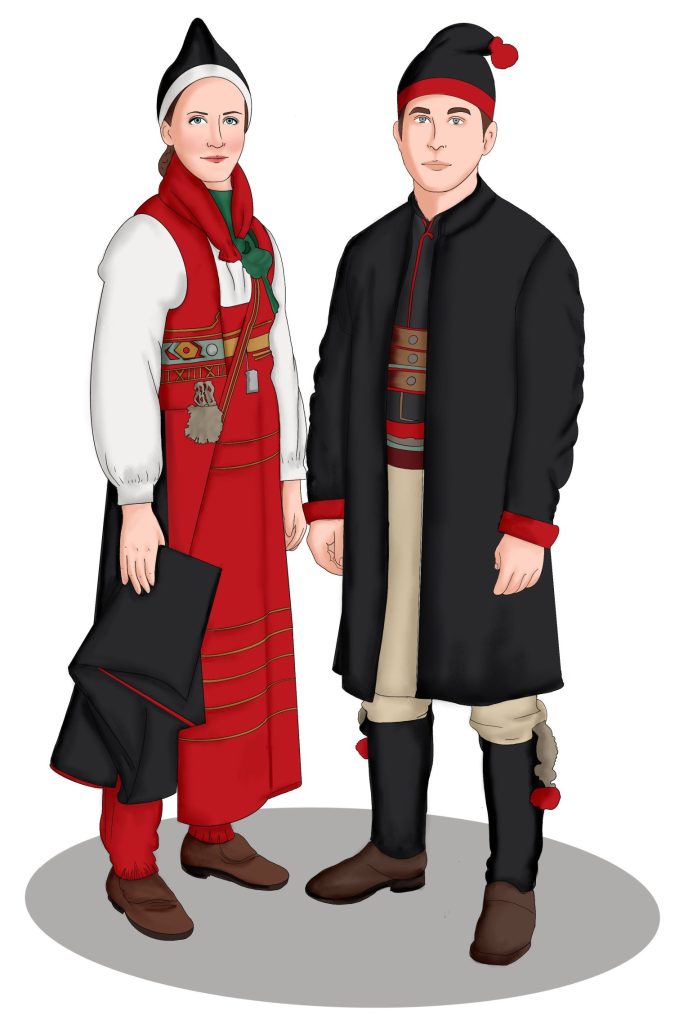
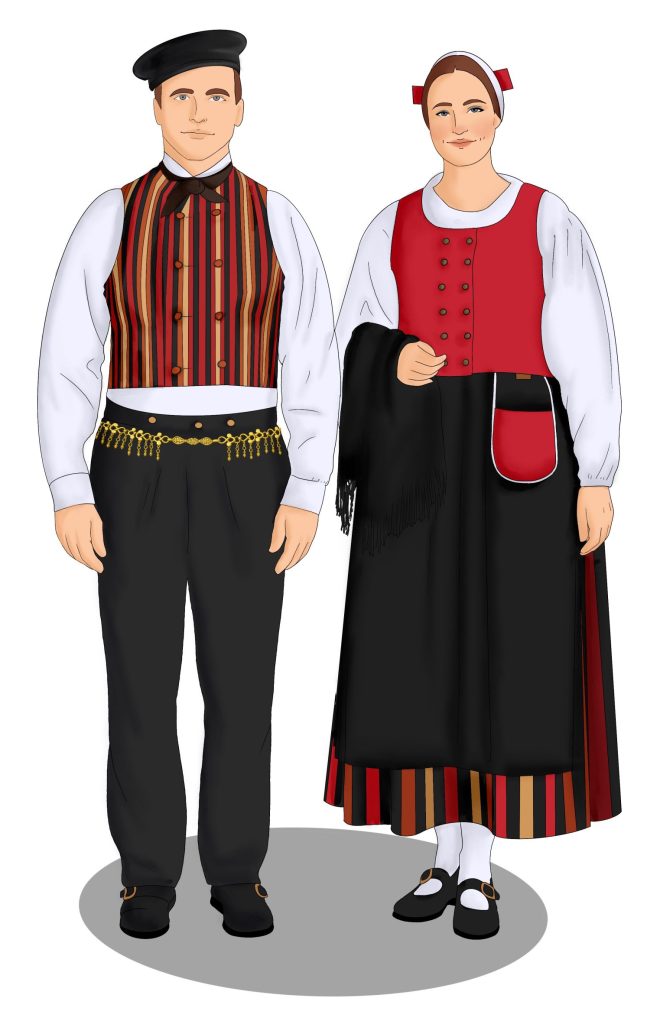
2.2. Music
The music of Scandinavia is largely centered around string instruments. They have their own version of the fiddle, known as the Hardanger fiddle (named for the Hardanger region of Norway), which has more strings than a traditional fiddle. One layer of strings lies underneath the main strings and vibrates “sympathetically” with the main strings, giving a distinctive sound to the instrument. Hardanger fiddles often have elaborately decorated fretboards. One of the strangest instruments found in Scandinavia is the Nyckelharpa. This instrument has keys that change the notes like a piano, but it is bowed like a fiddle. In Norway, you sometimes hear the jaw harp. Very often Scandinavian dancing is done to the dancers singing acapella. There are also a variety of other instruments including bagpipes and strummed lyres called Kantale.
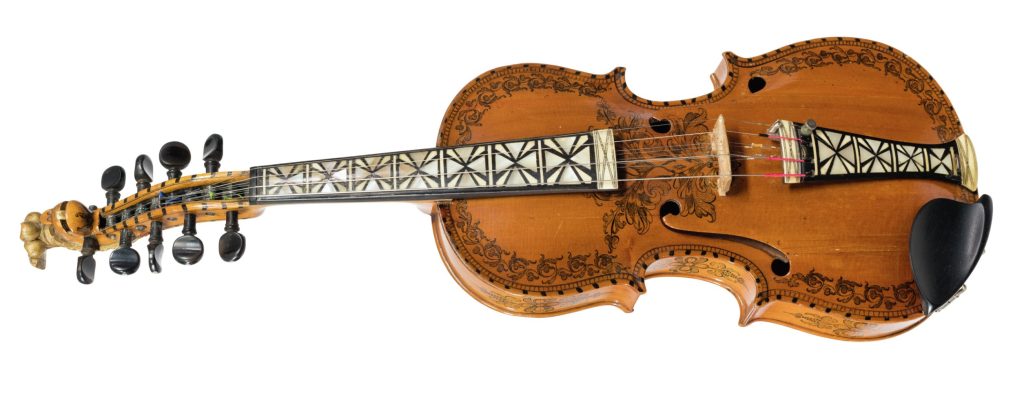

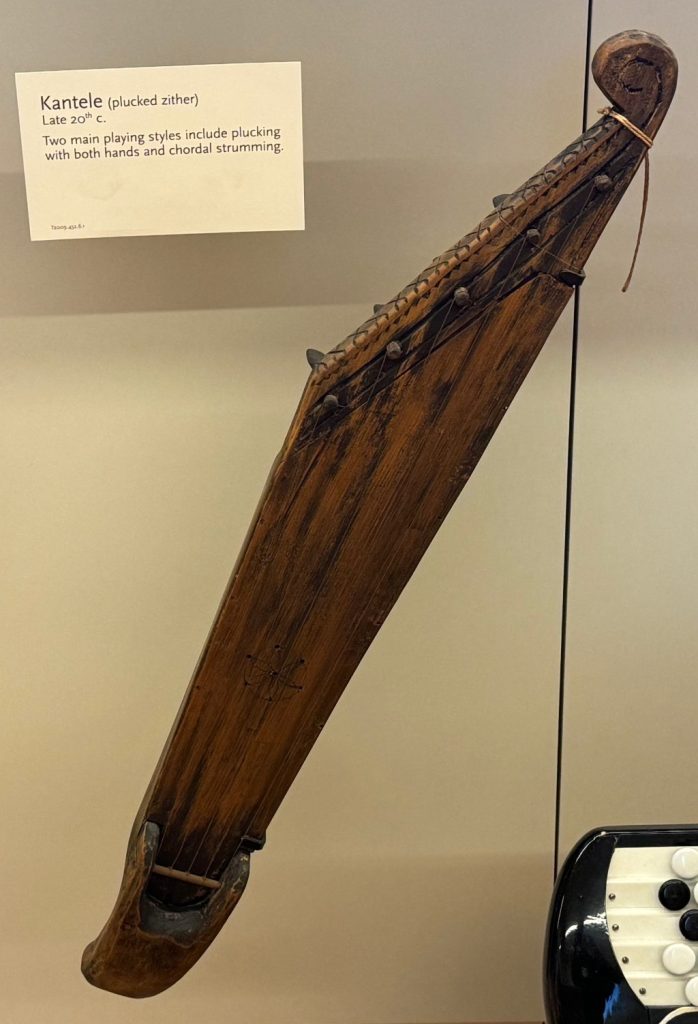
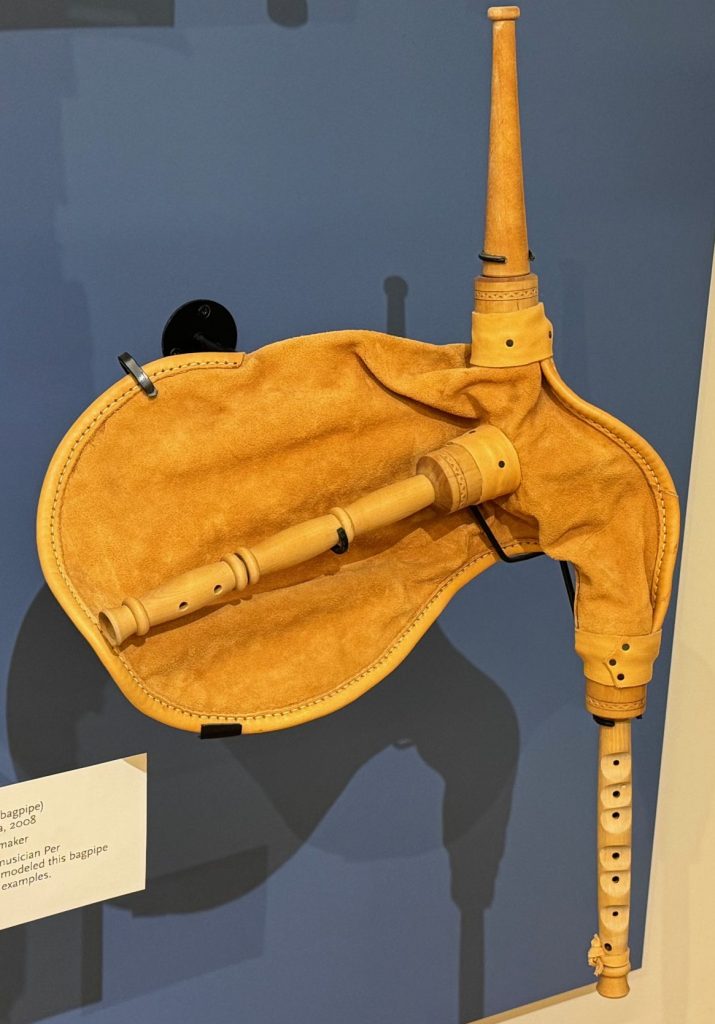
- Hardanger fiddle: https://youtu.be/Di1F8GUvEtg
- Nickelharpa. The band Väsen: https://youtu.be/oww-dXf-6qs
- Norwegian Jaw Harp: https://youtu.be/Pk_-Z4qok4M
2.3. Dance
There are four main styles of Scandinavian Dance, two of which are probably ancient and two of which are of a more recent vintage.
The Halling is a spectacular style of solo male dancing where the man struts around performing acrobatic feats that put break-dancers to shame. The Halling comes to a dramatic climax when a woman standing on a chair holds the man’s hat high up on a stick, and the man must leap up in the air to kick it off. One can imagine Viking warriors showing off for one another and their partners with this dance.
The other old-style dances are line dances. Although Scandinavia is now mostly protestant, like most of western Europe the area was historically Catholic; so, its line dances circulate clockwise rather than counterclockwise. These dances are almost always done to the dancers singing rather than to a band. Two such old-style line dances are the Langdans from Sweden and the Vikivaki from Iceland.
Of the more recent dances styles, and by far the most common kind of Scandinavian dance, is the couple dance. They do several types of couple dances. Typical dances include the Schottis, Hambo, Pols, Vals, Polska. In Hambos and Pols the leader and the followers do the same steps, but they do them slightly out of sync with each other. For example, in the Hambo, the leader and follower do precisely the same footwork, but they do it offset by one beat.
We should note that Scandinavia has experienced a revival of interest in traditional folk dancing, just like most other European countries. For example, in Sweden, beginning in the late 19th century and well into the 20th, many traditional dances were collected and notated into a sort of “bible of dances” (Beskrivning av Svenska) popularly called the Green Book in English. Researchers also traveled throughout the country seeking older dancers who remembered old dances that had disappeared. Today, the old dances have become the basic vocabulary for newly created ones that are danced to modern melodies and musical arrangements. Scandinavian folk dance is still a living tradition.
The other kind of relatively recent dance style is the Engelska. These are set and square dances. Based on the name, it’s thought that they might have been brought to Scandinavia by English sailors. This is supported by the fact that they are often done to music associated with the English Navy, like hornpipes (Hornfiffen). But even if that is not the case, they certainly are meant to be done in the style of English Country dances.
- Halling: https://youtu.be/T-_MMSEZSs8
- Alexander Rybek and Halling: https://youtu.be/l71CrtxvGCI
- Langdans fran Solleron: https://youtu.be/uT-nHWsW-q8
- Vikivaki: https://youtu.be/7Ow4UBTfh3g
- Hambo: https://youtu.be/fif8Zt1ir70
- Stabberlander: https://youtu.be/nUxLD8LpMdI
- Rørospols: https://youtu.be/xlimTPK5j6M
- A modern dance, Stickans Hambo: https://youtu.be/MtcXpOwYuPk
- Engelska Vagnhard: https://youtu.be/acDAazn8jZg
- Trekantet Sløjfe (Denmark): https://youtu.be/U6JrBAlD4J8
3. The Low Countries
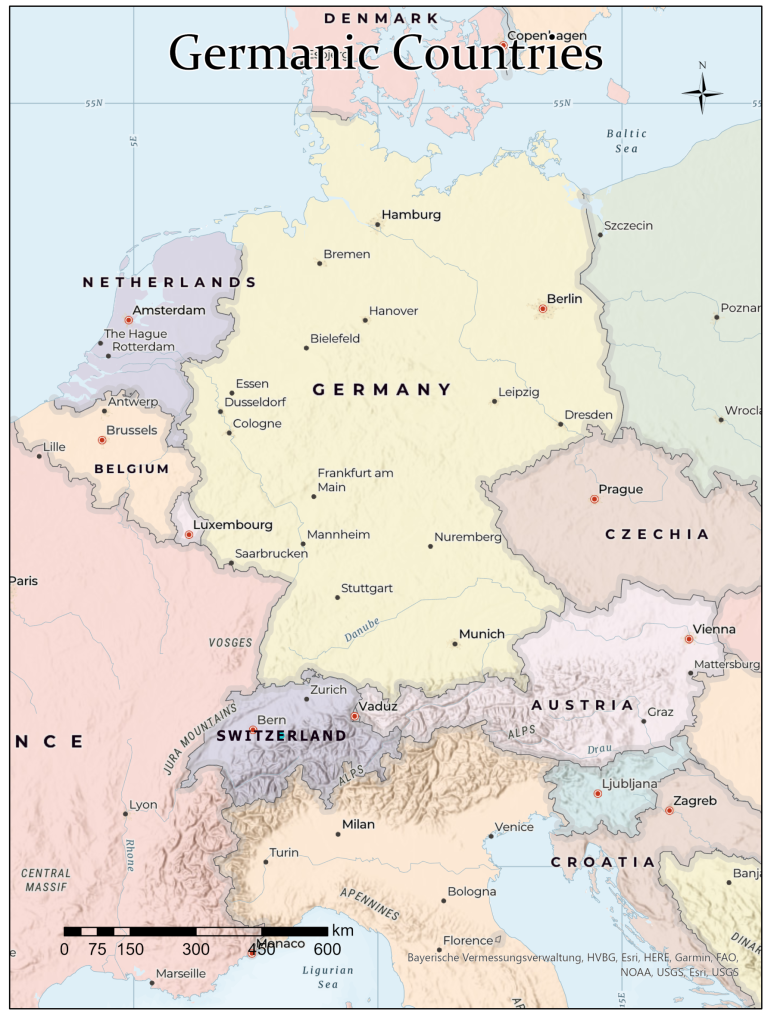
The name of the Netherlands literally means “low country” because much of the country is below sea level. In English, it is often known as Holland, but Holland refers to a province within the country. Although subject to the occasional devastating floods, and now threatened by rising sea levels, the fertile plains of the Netherlands are kept dry because of a combination of dikes and windmills which pump water back into the sea. The Netherlands was once a colonial power and was once a colony itself. For a while, they were ruled by Spain, but then the Dutch ruled Indonesia and had colonies and “possessions” on every continent. Their rule over Indonesia was often considered brutal. Today, the Dutch are known for their flower markets and chocolate, their liberal policies on drugs and sex, and for their largely tolerant approach to multiculturalism.
Belgium is also a country with a checkered colonial history. The people of the Congo were mistreated mercilessly under King Leopold II in the 19th century. But like its neighbor to the north, Belgium is now considered a haven for progressive views. Brussels, its largest city, is the location of the European Parliament. Belgium is a tricultural country. It has three official languages: Flemish – a language closely related to Dutch and spoken by the people who live in Flanders and the west; French, which is spoken by people in the south, and German, which is spoken by a tiny minority on the border with Germany.
Luxembourg is a small nation between Belgium, Germany, and France. In addition to French and German, they speak a distinct dialect called Luxembourgish that’s related to Flemish and German and shows the influence of French. Because of its geographic position, Luxembourg was declared an independent and neutral country in 1867 by the Treaty of London.
3.1. Traditional Dress
The most noticeable feature of the costumes of the low countries is the footwear. Wooden clogs were crucial to getting around in the wet, marshy reclaimed land. And these clogs figure prominently in the dances and culture of these countries. Men often wear black straight pants and black shirts with kerchiefs around their necks. Black tams are worn on the head. Women wear calf-length skirts, aprons, and lace hats with distinctive starched rolls.
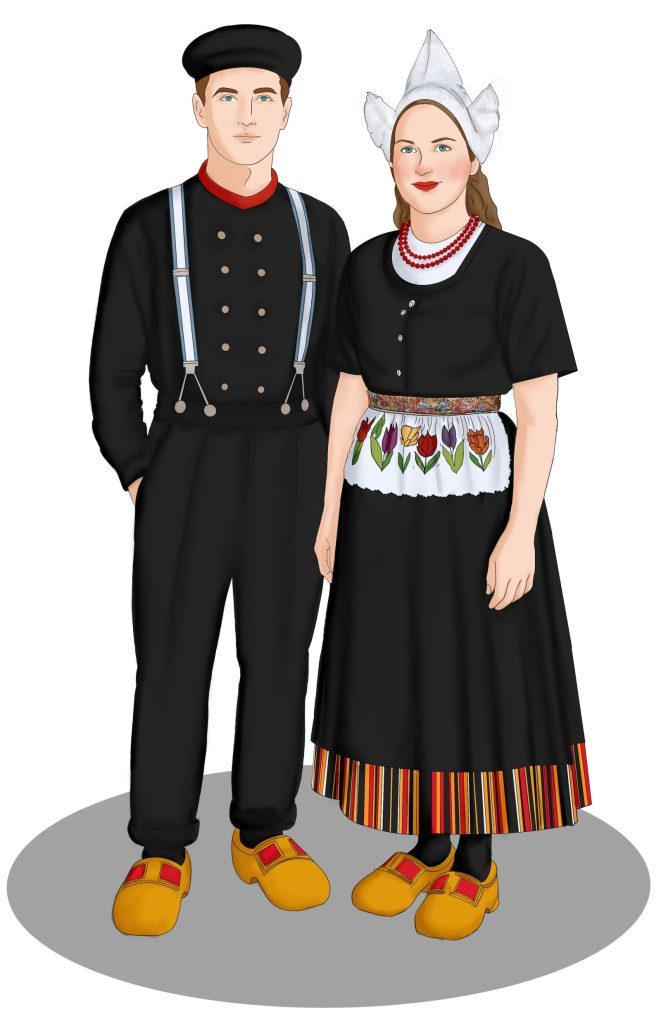
3.2. Music and Dance of the Low Countries
The musical instruments of the Dutch and Belgians are very similar to that of their German and French Neighbors. Fiddles and accordions are the primary instruments although you’ll also find the saxophone, oboe, and clarinet played by bands.
Most traditional dances are a mix of couple dances and mixers. Interestingly in the past 40 years, perhaps because of the high regard for internationalism in these countries, international folk dancing has become quite popular.
Klompendans (Clog dancing) is the most unusual style of dance of the Dutch. Unlike Clog and Step dance traditions of Britain and America, which rely on tight rhythmic movements, the Clog dances of the Dutch are much simpler. They must do simpler steps because the wooden clogs are more challenging to dance in. Dutch dances tend to be simple figure and set dances, where the dancers “clomp” their way through.
- Klompendans: https://youtu.be/JGMoKCHSGuc
- Klompendans (Andre Rieu): https://youtu.be/rVkrGJxdhuI
- Dutch Clog dancing in the US: https://youtu.be/l11CZMefIJQ
4. The Central Germanic Cultures
Germany, Switzerland, Austria, and their tiny neighbor Liechtenstein, are the major countries of Central Europe. Germany, Lichtenstein, and Austria are mostly German speaking; Switzerland also has a large German-speaking population, but French, Italian and Romansch are also official languages. Austria, Lichtenstein, and Switzerland sit in among the Alps. The geography of Germany is more varied, with mountainous forests in Bavaria and plains in the north.
Austria was one of the two centers of the Habsburgian Austro-Hungarian Empire and a world power for many decades. The Ottoman Turks tried to invade in 1683 and failed, so Austria demarcated the boundary between the eastern and western Europe. The assassination of Austria’s Archduke Franz Ferdinand was the catalyst for World War I. During the period of the lead-up to World War II, Austria was one of the firstcountries annexed by the Nazis into the Third Reich. Since the war, Austria has been a parliamentary democracy.
Germany didn’t really exist as a unified country until 1871, when Otto von Bismark united a patchwork quilt of small principalities, duchies, and city states into the German Empire, ruled by a king called the Kaiser. During the First World War, Germany under the Kaiser fought brutal battles against the western European powers. When they lost, the country suffered from reparations and economic sanctions, so Germany became the hot bed of radicalized politics on all sides of the political spectrum. The country adopted the fascist ideology from the Italians and Hitler’s dictatorship led to the Nazi genocide and the Second World War. After the war, the country was divided into two halves. West Germany fell under the influence of the Western Allies; East Germany became a communist satellite state under the sway of the Soviet Union. The late 1980s and early 1990s saw the fall of the Berlin Wall and the reunification of Germany into a single country. Modern Germany is not only one of the largest economies in the world; it is widely regarded as a world leader in politics too.
It’s easy to forget about little Liechtenstein tucked in between Switzerland and Austria, largely because it is culturally and economically dominated by its bigger neighbors. But it is a politically independent country.
Even though the Swiss are a linguistically diverse people (having four national languages), they have formed a tight political union since the late medieval period. They have consistently practiced official neutrality in wars; and, because of their alpine geography, they’ve been largely successful in staying out of conflicts and being invaded. They have a unique form of direct democracy, where laws must be passed through direct votes of the people. At the same time, it is a deeply conservative country. Women only achieved the right to vote in 1971! When people think of Switzerland, they often think of Swiss Army knives, chocolate, fondue, and skiing.
4.1. Traditional Dress
The folk costumes from this part of Europe are very distinctive. The women wear dirndls, which are full knee-length skirts with a very low cut bodice. Women wear a white poofy-sleeved blouse under the dirndl. It’s thought that the dirndl is a direct adaptation of the fashion of late 18thcentury working women which was then adopted as a national style. Men wear lederhosen. These are particularly distinctive for two reasons. First, they are often shorts (although Austrian lederhosen can be knee-length or even ankle-length), and they are made of leather. They are usually held up by leather suspenders, but decorated cloth suspenders have become common as well. The male dancers wear knee-high socks, which are typically green or white. On their heads the men wear a “Tyrolian” hat that is decorated with a band, feathers and—these days— with enameled metal pins showing where the wearer has travelled.
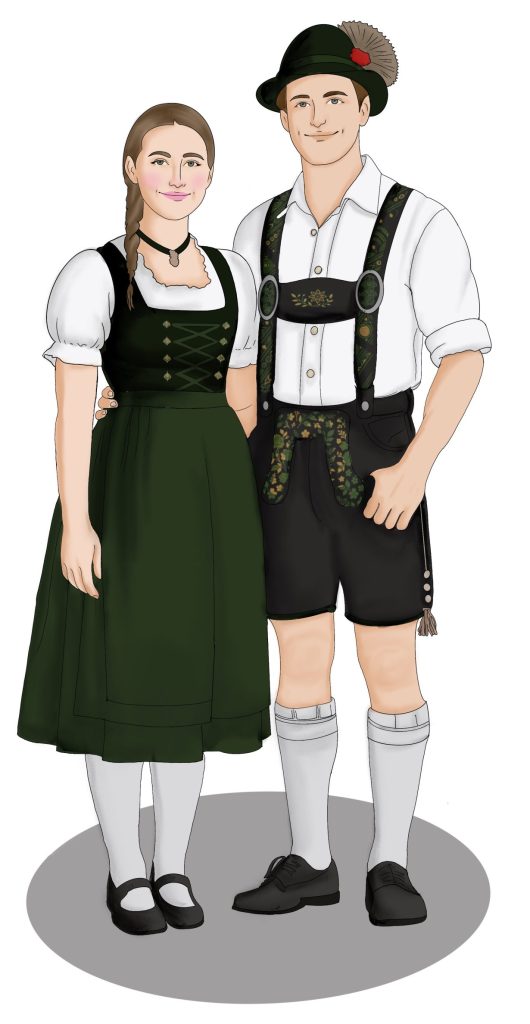
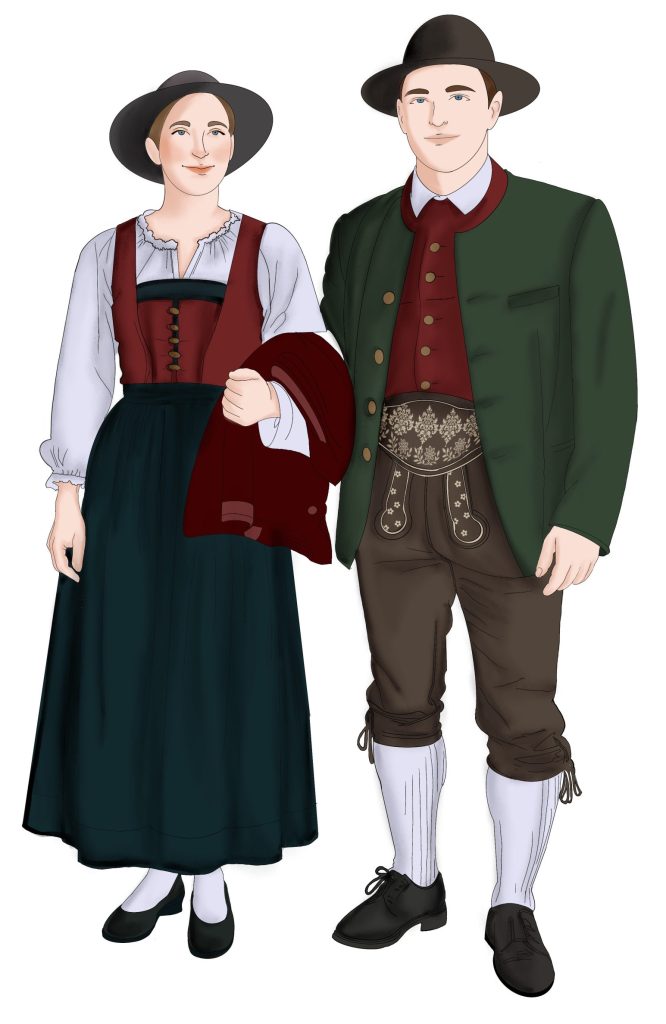
4.2. Music and Dance
The most common instrument in German dance music is the accordion. But you also find a strong tradition of brass instrumentation, often known somewhat derogatorily as “oompah music.” This term mimics the sound of German polka music.
- Accordion music: https://youtu.be/2wxAO_z5VNA
- Oompah: https://youtu.be/HpqTD3Y0YsU
There are several styles of Central Germanic dances. All the regions make use of set and square dances borrowed from the French court dances. They also all have strong traditions of couple dances. The modern Waltz comes directly from the ballrooms of Vienna. One fascinating couple dance is the Zweifacher, which uses music in complex musical patterns of both 2/4 and 3/4. When you do a Zweifacher, you pivot (turning walks) on the bars that are in 2/4 and waltz on the bars in 3/4. The video linked below shows one of the more complicated Zweifachers, called Schneider Schneider. The MIT Folk Dance Club has a T-shirt with formula (((P2W)2W)2(P2WP3W2)2 printed on it. The purpose of the shirt is so your partner can remember the sequence by reading it on your shirt. A subscript number tells you how many of the Waltzes (W) or Pivot steps (P) you do. So, Schneider is Pivot Pivot Waltz, Pivot Pivot Waltz Waltz, Pivot Pivot Waltz, Pivot Pivot Waltz Waltz, Pivot Pivot Waltz Pivot Pivot Pivot, Waltz Waltz, Pivot Pivot Waltz Waltz, Pivot Pivot Waltz Pivot Pivot Pivot, Waltz Waltz. That is an amazing sequence!
Another distinctive style of dances is the couple dances where the dancers make tight twists and turns without dropping hands, thereby tying themselves into knots and then untwisting. The most famous of these dances is the Austrian Laendler, which was featured in the movie The Sound of Music. However, many other such dances exist.
The other dance style that many people are familiar with from popular culture is the Plattl. These are the clapping and slapping dances. One of the most famous examples is in the movie European Vacation where Chevy Chase gets beat up by a troupe of dancers. These dances are often performance dances so use props and tell stories through pantomimes. Some dances also combine arm twists and plattls.
- Set Dance: Sauerlander Quadrille: https://youtu.be/hq6JEUAr5bc
- Viennese Waltz: https://youtu.be/dIYrMO_AfdI
- Traditional couple dance: Marklander: https://youtu.be/eLXDQGKACso
- Zweifacher (Schneider): https://youtu.be/HZ1U6UFKKW8
- Rosentaller: https://youtu.be/eVmp1Nk9Lo8
- Unterstierer: https://youtu.be/cfLHQ7M5a9M
- Zillertaller Laendler: https://youtu.be/GsgHN6yi4Lc
- Plattl: https://youtu.be/JRsqZL7u9Ug
- Bankeltanz: https://youtu.be/cfLHQ7M5a9M
- Holzhackerbaum: https://youtu.be/4E7iopJMqiQ
- Hofbrauhaus: https://youtu.be/XYRWOs5rVoY
- Schuplattler https://youtu.be/STlvnd1NNAY
Further Reading
- Bergquist (1919), Breuer (1948), Burchenal (1912, 1915a, 1915b, 1938), Collan and Heikel (1948),Fraeley (n.d.), Fife (1951), Witzig (1948), Van Der ven-ten Bensel (1949), Pinon and Jamar (1953), Krogsætter (1968), Reeak, Seamonson and Ralph (1971), Semb (1951), Salven (1949). See References section at the end of this book for full citations.
- https://en.wikipedia.org/wiki/Germanic_languages
- https://en.wikipedia.org/wiki/Luxembourg
- http://www.euronet.nl/~trio/public_html/
- https://en.wikipedia.org/wiki/Dutch_folk_dance
- https://en.wikipedia.org/wiki/Klompendansen
- https://en.wikipedia.org/wiki/Oom-pah
Some Suggested Dances for Teaching
Scandinavian Dances
- Vikivandi: https://folkdancemusings.blogspot.com/2020/04/vikivaki-sprengisandi-iceland_1.html
- Långdans från Sollerön: http://folkdancemusings.blogspot.com/2014/03/langdans-fran-solleron-sweden.html
- Little Man in a fix: http://folkdancemusings.blogspot.com/2015/01/bitte-mand-i-knibe-little-man-in-fix.html
- Haderianschottis: https://folkdancemusings.blogspot.com/2021/01/haderianschottis-sweden.html
- Klapperstycket: https://folkdancemusings.blogspot.com/2018/10/klapperstycket-sweden.html
- Norwegian Polka: http://folkdancemusings.blogspot.com/2014/04/norwegian-polka-parisarpolka.html
- Smygvals: https://folkdancemusings.blogspot.com/2021/12/smygvals-sweden.html
- Hornfiffen: https://folkdancemusings.blogspot.com/2020/02/hornfiffen-denmark.html
- Annasvisa: https://folkdancemusings.blogspot.com/2021/01/annasvisa-sweden.html
- Johan Pa Snippen: http://folkdancemusings.blogspot.com/2014/01/johan-pa-snippen-sweden.html
- Kalle P’s Vals: https://folkdancemusings.blogspot.com/2021/10/kalle-ps-vals-margots-valsen.html
Dances from the Low Countries
- Te Haerlem: http://folkdancemusings.blogspot.com/2018/02/te-haerlem-in-den-houte-netherlands.html
- ‘t Smidje: http://folkdancemusings.blogspot.com/2011/11/t-smidje-belgium.html
- Baonopstekker: http://folkdancemusings.blogspot.com/2015/05/baonopstekker-netherlands.html
- Pieternelle: http://folkdancemusings.blogspot.com/2015/05/pieternelle-belgium.html
Dances from the Central Germanic countries
- Siebenschritt: http://folkdancemusings.blogspot.com/2015/06/siebenschritt-germany.html
- Zigeuner Polka: http://folkdancemusings.blogspot.com/2015/01/zigeunerpolka-netherlandsnorth-germany.html
- Man in the Hay: http://folkdancemusings.blogspot.com/2015/01/man-in-hay-germany.html
- D’Hammerschmiedsg’selln: http://folkdancemusings.blogspot.com/2015/01/dhammerschmiedsgselln-germany.html
- Das Fenster: https://folkdancemusings.blogspot.com/2022/11/das-fenster-germany.html
Discussion Question
Discussion Question 1
In the 1930s and 1940s, the Nazis used German Folk Dance as a propaganda tool as a tool to fuel their nationalist ideology. Doing traditional German Folk Dance was considered to be a social signal for as a member of the so-called “master-race”. Special dances were even invented for the Hitler Youth. During the same time period, in the United States, German Folk Dancing was rarely performed even by German immigrant communities. After the war, it took a long time for German dancing to be done in the USA again, but in the 1950s many US soldiers brought German dances back to the US and it saw a revitalization. What does all of this tell us about the role of folk dancing in politics?
Media Attributions
- Figure 9.1: Map of Scandinavia (except Iceland) © John W. W. Powell. Used with permission.
- Figure 9.2: Norwegian Folk Costumes © Asma, used with permission
- Figure 9.3: Swedish Costumes © Asma, used here with permission
- Figure 9.4: Costumes of Finland © Asma, used with permission
- Figure 9.5: Hardanger Fiddle © Musical Instrument Museum, Phoenix. Used with permission
- Figure 9.6: Nyckelharpa © Musical Instrument Museum, Phoenix. Used with permission
- Figure 9.7: Kantele, Finland © Musical Instrument Museum, Phoenix. Used with permission
- Figure 9,8: Sackpipa, Sweden © Musical Instrument Museum, Phoenix. Used with permission.
- Figure 9.9: Map of the non-Scandinavian Germanic countries, with the Low Countries on the Atlantic and the Central Germanic countries in the middle © John W. W. Powell, used with permission. Geospatial data is cited in map
- Figure 9.10: Dutch Folk Costumes © Asma. Used with permission
- Figure 9.11: Bavarian Style (German) costumes © Asma. Used with permission
- Figure 9.12: Austrian style costumes © Asma, used with permission

